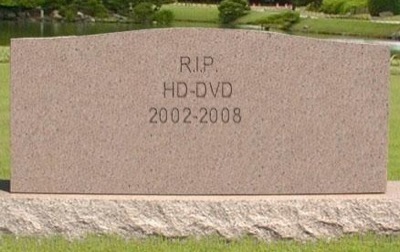
I've been talking to a couple of reporters over at Wired lately about the aftermath of the HD-DVD/Blu-ray war (I'm waiting for a declaration that February 20 will forever be commemorated as HD armistice day). The upshot of my comments to date has been 1), that Blu-ray was crowned the winner by the studios and CE manufacturers in 2006, and 2) Apple's role in Blu-ray is more about creating Blu-ray content than playing it. But I thought Notes From Anywhere readers might be interested in some additional factors that haven't been getting as much press play.
Daniel Eran Dilger over at roughlydrafted.com made some good points I'd forgotten about the HD-DVD vs Blu-ray war, among them that HD-DVD carried with it the proprietary lead weights of Microsoft's Windows Media Player, WinCE, and VC-1 coders built into the standard. And while VC-1 was supported in Blu-ray, it relied more on H.264 which was a true international standard. It should come as no surprise that Hollywood, having seen the movie of Microsoft using proprietary standards to become the toll collector an an industry before, rebelled, and therefore ended up siding with Sony, who was at least, "one of them." It also didn't help that Microsoft, in its usual inimitable development style, was consistently late in delivering its technology software to HD-DVD partners, which caused Toshiba's early technology lead to evaporate.
One other data point I'd forgotten was that Michael Eisner at Disney was originally a Microsoft/HD-DVD fan and licensee of Windows DRM, but when he left in 2004, Disney became a Blu-ray supporter. That defection may have started the stampede away from HD-DVD, and Disney's purchase of Pixar and Steve Jobs sealed the deal.
One point I had made in articles I wrote about this technology war in 2005 was the two of the big supporters of HD-DVD were Microsoft and Intel, each of whom could account for exactly zero million HD-DVD drive sales. Whenever I see "Barney alliances" -- ones where no money changes hands, but all the partners agree to love each other and their technologies --- I always consider it a sign that the partnership is going to fail. As someone once said, anything worth doing in business is worth doing for money. And when there's no money at stake, there's no business. The death of HD-DVD proved that rule again.
One final Anywhere note to this obituary: as my colleague Andy Jaquith noted in a press interview recently, DRM is the mortal enemy of Anywhere media. The HD-DVD battle taught Toshiba that lesson, but Sony has yet to learn it, despite its ATRAC defeat at the hands of Apple's less heavy-handed DRM. Sony's Blu-ray may have won the high-def format war, but there are still many battles to come to win over Anywhere consumers, who will be inundated with on demand offerings, downloadable media, and innovative media-repurposing technologies like Slingbox. In our increasingly digital world, collections of ones and zeros will become increasingly more difficult to protect. Sony should learn from Toshiba's mistake and think beyond Hollywood's demands for more and more DRM. If it doesn't, Blu-ray's victory could be short-lived.
Update: One commenter notes that WinCE and Windows Media Player were never part of the HD-DVD spec. I personally haven't read the spec, so I can't prove or disprove the assertion, but Microsoft certainly claims these are key and essential parts of reference HD-DVD implementations. I apologize for any confusion.

1 comment:
I sent the author an e-mail days ago with references containing multiple corrections, but it was ignored. Would he at least consider posting a correction stating that neither Windows Media Player nor WinCE were part of the HD DVD spec?
Post a Comment